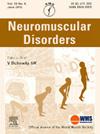364P Gross motor delays in boys with Duchenne muscular dystrophy are seen in infancy
IF 2.7
4区 医学
Q2 CLINICAL NEUROLOGY
引用次数: 0
Abstract
There is an increased focus on the developmental abilities of infants and young boys with Duchenne Muscular Dystrophy as clinical trials are increasingly enrolling younger cohorts. Normal maturational gains in gross motor skills, however, makes clinical trials challenging as it is difficult to determine if post-treatment improvement is attributable to the therapeutic or simply to maturation. While there is some understanding of the natural history of infants and toddlers with DMD, there is an urgent need to objectively quantify motor function in this young cohort using a normative-referenced scale to enable data-driven decision-making in these early years. Several countries have now implemented newborn screening for DMD which will allow for diagnosis within the first few weeks of life. Families will likely have questions about trial participation or initiating approved therapies. This submission reports on the prevalence of gross motor delay and documents the trajectory of gross motor skill acquisition in boys with Duchenne muscular dystrophy using the Bayley Scales of Infant & Toddler Development, Third Edition (Bayley 3). Ninety boys (2 months – 5.8 years at their first visit) were evaluated during regularly scheduled clinic visits. Deletion was the most common genetic variant (69%), but the sample included duplications, nonsense, splice site and INDEL variants. We report on longitudinal assessments for 47 boys, with two to six follow up visits, resulting in 128 total assessments. All boys had a delay in gross motor skills when compared with normative controls at least one visit. Although the Bayley 3 was designed for use in children under the age of 42.5 months, none of the older boys in this cohort achieved a perfect score suggesting it could be used until age 6 years. Raw scores increased with age; however, a plateau was noted at 5 years. The average scaled score (which compares a boy's performance to age matched peers; mean=10; SD= 3) was 5 which indicates a significant delay and is 1.6 standard deviations below the mean. Five out of the 90 boys (5.5%) received a scaled score within the normal range at one visit, but this was not maintained over time. The minimum detectable change for this cohort was 4.8 raw points and 1.01 scaled points. Interestingly, there were several items that presented more difficulty than would be expected for their age. These included jumping forward, jumping down from a step, heel-toe walking, standing on one foot for 8 seconds and using a reciprocal pattern to climb stairs. With newborn screening and interventional trials recruiting younger cohorts it is imperative that we understand the typical developmental trajectory of infants and young boys with DMD. A well-documented developmental natural history study could be used to determine if the rate of change in gross motor development following an intervention falls outside of expectations for DMD.
364P 患有杜兴氏肌肉营养不良症的男孩在婴儿期出现粗大运动迟缓
随着越来越多的临床试验开始招募年龄较小的患者,人们越来越关注患有杜兴氏肌肉营养不良症的婴幼儿和男童的发育能力。然而,由于难以确定治疗后的改善是归因于治疗还是单纯的发育成熟,因此大运动技能的正常成熟增长使临床试验面临挑战。虽然人们对 DMD 婴幼儿的自然史有了一定的了解,但仍迫切需要使用常模参照量表对这一幼年群体的运动功能进行客观量化,以便在这些幼年时期做出以数据为导向的决策。目前,一些国家已经实施了新生儿 DMD 筛查,这将有助于在婴儿出生后几周内进行诊断。家庭很可能会对参与试验或启动已获批准的疗法产生疑问。本研究报告采用贝利婴儿和幼儿发展量表第三版(Bayley 3)对患有杜兴氏肌肉营养不良症的男童的大运动迟缓患病率进行了报告,并记录了他们大运动技能的习得轨迹。90 名男童(首次就诊时 2 个月至 5.8 岁)在定期门诊就诊时接受了评估。缺失是最常见的遗传变异(69%),但样本中也包括重复、无义、剪接位点和 INDEL 变异。我们报告了对 47 名男孩的纵向评估结果,这些男孩接受了 2 到 6 次随访,总共接受了 128 次评估。与正常对照组相比,所有男孩的粗大运动技能至少有一次出现延迟。虽然 Bayley 3 是为 42.5 个月以下的儿童设计的,但在这批男孩中,没有一个达到满分,这表明 Bayley 3 可用于 6 岁以下儿童。原始分数随着年龄的增长而增加,但在 5 岁时出现了一个高点。平均标度分(将男孩的表现与年龄匹配的同龄人进行比较;平均值=10;标准差=3)为 5 分,这表明男孩的发育明显迟缓,比平均值低 1.6 个标准差。在 90 名男孩中,有 5 名男孩(5.5%)在一次就诊时获得了正常范围内的评分,但这一评分并没有随着时间的推移而保持下去。该组学生的最小可检测变化为原始分 4.8 分和标度分 1.01 分。有趣的是,有几个项目的难度超出了他们的年龄预期。这些项目包括向前跳跃、从台阶上跳下、脚跟到脚尖行走、单脚站立 8 秒钟以及使用往复模式爬楼梯。随着新生儿筛查和干预试验招募更年轻的群体,我们必须了解患有 DMD 的婴儿和男童的典型发育轨迹。我们可以利用一项有据可查的发育自然史研究来确定干预后粗大运动发育的变化率是否超出了对 DMD 的预期。
本文章由计算机程序翻译,如有差异,请以英文原文为准。
求助全文
约1分钟内获得全文
求助全文
来源期刊

Neuromuscular Disorders
医学-临床神经学
CiteScore
4.60
自引率
3.60%
发文量
543
审稿时长
53 days
期刊介绍:
This international, multidisciplinary journal covers all aspects of neuromuscular disorders in childhood and adult life (including the muscular dystrophies, spinal muscular atrophies, hereditary neuropathies, congenital myopathies, myasthenias, myotonic syndromes, metabolic myopathies and inflammatory myopathies).
The Editors welcome original articles from all areas of the field:
• Clinical aspects, such as new clinical entities, case studies of interest, treatment, management and rehabilitation (including biomechanics, orthotic design and surgery).
• Basic scientific studies of relevance to the clinical syndromes, including advances in the fields of molecular biology and genetics.
• Studies of animal models relevant to the human diseases.
The journal is aimed at a wide range of clinicians, pathologists, associated paramedical professionals and clinical and basic scientists with an interest in the study of neuromuscular disorders.
 求助内容:
求助内容: 应助结果提醒方式:
应助结果提醒方式:


